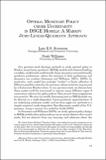Artículo
Optimal monetary policy under uncertainty in DSGE models: a markov jump-linear-quadratic approach
Fecha
2009Resumen
Our previous work develops methods to study optimal policy in Markov jump-linear-quadratic (MJLQ) models with forward-looking variables: models with conditionally linear dynamics and conditionally quadratic preferences, where the matrices in both preferences and dynamics are random (Svensson and Williams, 2007a, 2007b). In particular, each model has multiple “modes”—a finite collection of different possible values for the matrices, whose evolution is governed by a finite-state Markov chain. In our previous work, we discuss how these modes could be structured to capture many different types of uncertainty relevant for policymakers. Here we put those suggestions into practice. We start by briefly discussing how an MJLQ model can be derived as a mode- dependent linear-quadratic approximation of an underlying nonlinear model, and we then apply our methods to a simple empirical mode-dependent New-Keynesian model of the U.S. economy, using a variant of a model by Lindé (2005).
Colecciones
Descargar


